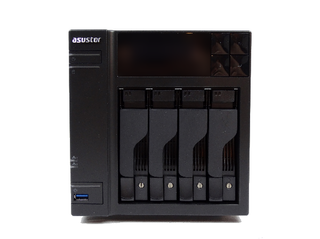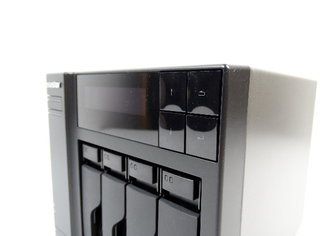Asustor AS6204T NAS Review
Why you can trust Tom's Hardware
A Closer Look





The AS6204T ships in a retail-friendly package. Inside, we find the appliance secured in place by dense foam. Its accessories come in a separate box that keeps them from scratching the chassis.

Asustor is a fairly young NAS vendor, and this design dates back to its earliest products launched in 2012. The layout remains clean and modern, though. That's a good thing, as we've started seeing more appliances loaded with plastic to reduce manufacturing costs.


There are several LEDs that indicate power, disk and network activity. When engaged, the one-touch copy function LED also comes to life. All of the lights, including the LCD display up front, can be dimmed or even turned off completely. This is a welcome addition, particularly when the AS6204T sits at the heart of a media center.

Once you get past the setup process, the LCD becomes a novelty more than anything. Prior to that, it'll walk you through configuration and flash the IP to use for accessing the NAS. Should a problem arise later, though, the display can help point you in the right direction.

Over the years, we've heard companies argue in favor of single- and dual-fan designs. Asustor uses one low-speed fan to keep the drives inside cool. Those large blades do help minimize noise, and Asustor claims that the system at idle generates just 17.6 dB(A). That's lower than we can accurately measure outside of an anechoic chamber. Almost all of what you hear from the AS6204T comes from whatever hard drives are inside.
The single-fan design does have one drawback: it adds a single point of failure. Then again, we've tested a number of Asustor appliances and never seen a fan go out. Replacing it wouldn't be difficult, but we also know most folks don't keep spares.


Most of the platform's I/O is accessible from the back, along with a Kensington ClickSafe lock slot. We rarely see eSATA anymore, but we applaud Asustor for keeping the interface; the capacity it enables is useful when you run out, and its performance matches native SATA. You can also offload surveillance recordings to a more secure space using external disks.
Several competing systems also include HDMI connectivity, but the S/PDIF audio output is more unique. Software like XBMC (now under the name Kodi) takes advantage of those hardware capabilities to enable a personal library of entertainment for your living room. Asustor leads with this feature, though other companies are taking steps to close the gap.


The system is mainly metal, including a steel frame and aluminum cover that goes over three sides. We prefer metal cases; they help dissipate thermal energy under heavy workloads. This system uses very little power, but high-capacity drives with a lot of platters do get hot.



The drive sleds support both 3.5-inch and 2.5-inch disks. The only fault we found with them is their locking mechanism, which isn't particularly secure. We'd prefer to have a key lock the sleds to the chassis. This is important to SMBs that might not have space free of foot traffic and meddling hands.
Stay on the Cutting Edge
Join the experts who read Tom's Hardware for the inside track on enthusiast PC tech news — and have for over 25 years. We'll send breaking news and in-depth reviews of CPUs, GPUs, AI, maker hardware and more straight to your inbox.
-
JQB45 I wish they would just sell the case in mITX size. Then I could add more own OS and other hardware.Reply
-
littleleo I have the ASUSTOR AS-202TE hooked to my living room TV. Some of the apps are just not functioning as promised but for what I paid it was a good deal.Reply -
CRamseyer 8GB max for the system memory. The limitation is from Intel on this processor / chipset.Reply -
HideOut Again, just get a Buffalo 441e and put your own drives in it. It's not as fact, but its about $190 for the system + whatever 4 drives you use.Reply -
Xajel I'm looking for a 4-bay NAS, it will be my first one.. but I need three more features: Link Aggregation, Upgradable RAM & Visualization.. I know there's multiple options including this I'm not in hurry for the matter.. but why do you guys make a comparison table in each review...Reply -
DaDude1 ReplyI wish they would just sell the case in mITX size. Then I could add more own OS and other hardware.
There are cases like this available. I looked at them a few month ago (approx. $180 for 5 bays), but finally settled on a node304 (6 internal bays) for my home server. I got the case for $50 (on sale on newegg), added the ASROCK H97 ITX with WLAN ($50 on sale), Celeron G3258 ($44) and CX430 powersupply ($10 after sale and rebate). The memory I used from my desktop (had 32 GB, so removed 16GB and added into the server) and I had as well 4 x 3TB WD Green in my desktop, which I added to the server (plus an old 120GB SSD as boot drive). I added as well a 8TB Seagate external ($200 on sale) and a 5TB Seagate external (paid $120 a while back) via USB3 for backups of the system. Got Windows 2012 R2 DataCenter from Microsoft (free educational license). Running right now on the box Home NAS, MediaConverter, Linux VM (OwnCloud), MSSQL VM, Windows Access Server VM and Windows Remote App/Desktop VM. I have approx. 7 GB Memory free on the box, which leaves plenty for additional VM's. The only disappointing aspect of this HomeNas/Server build is MS Storage Spaces or more specifically it's implementation of RAID5. I get with mirrored drives plenty of throughput, but writing to a RAID5 volume is running between 25 and 30 MB/s after the cache is used up. So when I transfer large volumes of data (some Datasets I use for analysis are in excess of 1TB), take forever to transfer to the volume. Overall the box cost me approx. $250 (excluding harddrives) and I take this anytime over any of the NAS boxes. I tried some of the NAS boxes (QNAP, Synology) and was very disappointed. If you have a bit of time (took me approx. 1 hour to build and approx. 6 hours to install and configure Windows 2012 R2) this would certainly be a better choice.
Getting back to cases look at the following:
Silverstone DS380 (8 hot-swap plus 4 x 2.5 internal) for $160
I believe Startech USA had a case that looked like the Asus or QNAP 4 bay units for approx. $180.
-
JQB45 @DaDude1 - I like the SilverStone DS380B you mentioned.Reply
Here is a custom build using the SilverStone DS380B that costs less then a Diskless Asustor AS6204T NAS
PCPartPicker part list / Price breakdown by merchant
CPU: Intel Pentium G4400 3.3GHz Dual-Core Processor ($59.99 @ SuperBiiz)
Motherboard: ASRock H110M-ITX/ac Mini ITX LGA1151 Motherboard ($67.99 @ SuperBiiz)
Memory: Kingston Savage 8GB (2 x 4GB) DDR4-2400 Memory ($49.99 @ Newegg)
Storage: Samsung 850 EVO-Series 500GB 2.5" Solid State Drive ($149.45 @ OutletPC)
Case: Silverstone DS380B Mini ITX Tower Case ($144.98 @ Newegg)
Power Supply: SeaSonic 300W 80+ Certified SFX Power Supply ($39.99 @ SuperBiiz)
Other: Linux - CentOS ($0.00)
Total: $512.39
Prices include shipping, taxes, and discounts when availableGenerated by PCPartPicker 2016-04-17 05:11 EDT-0400
All thats left to add is the hard drives. -
CRamseyer Great, so who do you call for support if something doesn't work right? Also, Linux isn't exactly user friendly for people coming from Windows. You are comparing apples to oranges here.Reply
